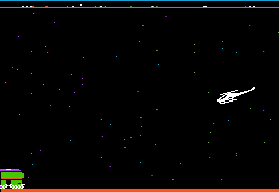I've been playing Hack on and off for a week, usually unable to pass the second level. Half the time I die (or suffer an unacceptable loss) it's my own carelessness; usually because I moved too fast in a dark tunnel and attacked something I shouldn't have, though more than once I descended the stairs and forgot to wait for the dog, which turns him feral when you return, and you need him early on. Some of the other times death is a lesson, but with increasing frequency it's something that felt unavoidable. Starvation because I didn't find any food, getting swarmed by monsters while resting to heal wounds from the last battle, getting dumped into the next level by a hidden trapdoor (what, am I supposed to search with every step?) without the dog, starvation while resting, etc.
I've learned some things though.
- I've lived longest as the knight, the only class to start with any decent armor, though with low strength and so much armor, he can't carry very much.
- Monsters sometimes leave corpses, which you should eat whenever possible - normal food is too scarce not to - unless they're poisonous (kobolds and acid blobs so far). Unfortunately, the knight's low strength means sometimes you can't pick up the corpse to eat it without shuffling your inventory around, and the dog might eat the corpse while you do this. Speaking of which, the dog won't eat poisonous corpses.
- Don't attack floating eyes. Let the dog do it.
- Killing leprechauns is a great way to instantly gain a level or two, but first make sure you've stashed your gold out of his sight.
I've decided to try to be a caveman, and that I'd be okay with occasional savescumming henceforth. I figured that the caveman's greatest weakness - poor armor - is more easily corrected than the knight's literal weakness of low strength. There were a few false starts, but when I found some +3 chain mail on the first level, I decided this would be my winning character, and this time I saved and backed up before going down to level 2.
 |
| There were a lot of boulders in this level! |
Some of my misadventures to come:
- On level 5 I got my strength sapped all the way down to 12 points by giant ants - I've heard before that this is a classic Nethack noob trap, but I'm not sure how this could have been avoided. Later, I foolishly attacked a nymph, whose song compelled me to strip my +3 chain mail, and stole it and a bunch of other stuff. A pack of orcs killed me on level 6.
- I simultaneously got messages that I "feel hungry" and "are worried about the dog." I went back for the dog, who started attacking me - I dropped a ration, but the game interpreted this as dropping all of my rations and the dog ate them all in one chomp. Pretty soon after that I starved to death, and an adventurer's guild scribe presumably wrote a heartbreaking children's novel based on the incident that scarred generations.
- I started teleporting around the level randomly and I couldn't figure out why. Something I ate? Something cursed that I picked up? A trapdoor dumped me down a level, and my dog must have followed but went feral and attacked. Dropping food for it didn't help, and as I neared death, I heard the howls of Cŵn Annwn.
-
I couldn't find my way out of a generated level 2. My dog and I starved to death searching for hidden doors.

Real nice to put a bear trap right in front of a door too.
And then, after making a new anchor save before entering level 3, I started randomly teleporting again. And I realized why - I ate a leprechaun. And the effect doesn't seem to expire. Theoretically I might be able to work with this, but it's honestly just too annoying. Time to restart.
I know I'm not going to be able to beat this without savescumming, but I don't want to completely deprive myself of the Hack experience - rolling with the punches, identifying items through logic, coming back from almost certain death through experimentation / sheer dumb luck, even losing significant amounts of progress. And no obvious compromise presents itself; without backups all setbacks are irreversible, with backups nothing discourages you from just reading every unidentified scroll and wearing every random piece of jewelry knowing you can revert to a backup at the first sign of trouble.






























